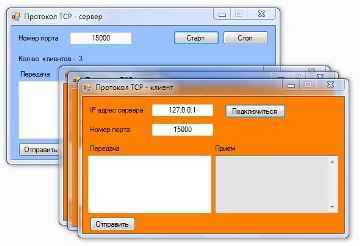Протокол TCP, отправка текстовых сообщений по сети
Сетевые приложения TCP

Сетевой протокол TCP
TCP аббревиатура Transmission Control Protocol, протокол (правила) управления передачей. Протокол TCP разработан для надежной передачи данных через сеть компьютеров. TCP (протокол управления передачей) для своей функциональности требует наличие постоянного соединения между сетевыми процессами. Разбивая отсылаемое сообщение на части, называемые пакетами, TCP помечает их таким образом, что независимо от очереди доставки этих пакетов сообщение будет собрано точно, так как оно и было изначально. Причем при потере части данных механизм протокола управления передачей запросит потерянные пакеты повторно. При этом он ещё и проверяет целостность каждого пакета. История TCP официально начинается с 1974 года, с тех пор написано много технических статей тщательным образом анализирующих механизм функционирования TCP.
Приложение сервер
Серверное приложение способно принимать запросы на подключение от нескольких клиентов. Для подключения использует блокирующий метод класса TcpListener.AcceptTcpClient возвращающий объект класса TcpClient . Чтобы не задерживать работу интерфейса программы данный метод запускается в отдельном потоке, останавливающийся после подключения установленного максимального количества клиентов. При успешном подключении запускается поток извлечения сообщений для каждого клиента отдельно. Метод ответственный за прием сообщений ReceiveRun(object num) в качестве параметра получает индекс подключившегося клиента. Сервер после получения сообщения ретранслирует его всем подключившимся клиентам. Потоки извлечения сообщений работают до завершения работы приложения или до остановки сервера.
Извлечение сообщения от клиента и ретрансляция полученного сообщения другим клиентам
Клиент-приложение
Исходник клиентского приложения более простой. Функции его заключаются в подключении к серверу и приему-отправки сообщений. Используются только блокирующие методы, причем метод извлечения сообщений ReceiveRun() работает в вспомогательном потоке, а метод отправки сообщений SendMessage() в главном потоке, поскольку сообщения отправляются почти мгновенно и практически не блокируют интерфейс.
Безопасный доступ к интерфейсу формы осуществляем сформированным методом ShowReceiveMessage(string message) проверяющим свойство объекта Control.InvokeRequired и в случае если обращение к элементу формы осуществляется из другого потока вызываем Control.Invoke с делегатом в качестве первого параметра, через второй параметр можно передать любой объект. ShowReceiveMessage можно безопасно вызывать в любом потоке.
Краткий листинг клиентского приложения
Инструменты программирования и исходник
Примечание. Исходник отправки сообщений по протоколу TCP тестировался в Microsoft Visual Studio 2010, Операционная система Windows, .NET Framework 3.5 выше. При необходимости проект исходного кода конвертируется для работы в MS Visual Studio 2008.
Отправка tcp пакетов windows
[SSH]
sequence = 12345:tcp,54321:udp
seq_timeout = 20
tcpflags = syn
start_command = /sbin/iptables -I INPUT -s %IP% -p tcp —dport ssh -j ACCEPT
cmd_timeout = 30
stop_command = /sbin/iptables -D INPUT -s %IP% -p tcp —dport ssh -j ACCEPT
[FTP]
sequence = 12345:udp,54321:tcp
seq_timeout = 20
tcpflags = syn
start_command = /sbin/iptables -I INPUT -s %IP% -p tcp —dport 21 -j ACCEPT
cmd_timeout = 30
stop_command = /sbin/iptables -D INPUT -s %IP% -p tcp —dport 21 -j ACCEPT
�������, ��� ����� ���� ������� ��� tcp ����� � ��������� �� ����� telnet, �� ��� ��������� ���� ��������. ��� ������������ ����� ������� ���� (������������) � ����� �� ��� Win7, ��� �� ������� �� ����� telnet ������, ��� � �������� .
 Re: �������� tcp/udp ������ �� ������������ ����/���� ����������� ���������� [new] Re: �������� tcp/udp ������ �� ������������ ����/���� ����������� ���������� [new] | |||
| bremborg Member ������: | ������� ���� (������������) �� ����� �������� TCP/UDP ������� ��� ��� ? � ��� ���� ������ ���������� � ��������������, �������:
� ������� ������ �� 20 �����. ������������ ���������� indy (��������� ��� 5 �����). | ||
| 26 ��� 11, 12:11����[11501348] �������� | ���������� �������� ���������� | |||
 Re: �������� tcp/udp ������ �� ������������ ����/���� ����������� ���������� [new] Re: �������� tcp/udp ������ �� ������������ ����/���� ����������� ���������� [new] | |
| bremborg Member ������: | � ������� ������� ��� UDP |
| 26 ��� 11, 12:15����[11501406] �������� | ���������� �������� ���������� | |
 Re: �������� tcp/udp ������ �� ������������ ����/���� ����������� ���������� [new] Re: �������� tcp/udp ������ �� ������������ ����/���� ����������� ���������� [new] | |||
| Dimitry Sibiryakov Member ������: |
������� �������� ������ ��� ����, ����� ����� ���� ������������ SSH ������ � ���������� Posted via ActualForum NNTP Server 1.4 | ||
| 26 ��� 11, 12:26����[11501575] �������� | ���������� �������� ���������� | |||
 Re: �������� tcp/udp ������ �� ������������ ����/���� ����������� ���������� [new] Re: �������� tcp/udp ������ �� ������������ ����/���� ����������� ���������� [new] | |||||||||
| ALex_hha Member ������: �������. �������. |
php/html ������������ 😀
�� �������� �� � � ��� ���� �� �++ builder, ������ ��� ������ � ������� ���������. �� � ������ �� ����, � knockd ���� ���� ������ � ��� �����, ������ ����� ������� ��� ���� ����� ������ ����� ��� ����, ��� ��������� ��������
��� ��� ���� ������ ��� ����������� ��� ������� 😉 �������������� ����� �� ssh
� �� ��� ���������� �� ������� | ||||||||
| 26 ��� 11, 13:12����[11502209] �������� | ���������� �������� ���������� | |||||||||
 Re: �������� tcp/udp ������ �� ������������ ����/���� ����������� ���������� [new] Re: �������� tcp/udp ������ �� ������������ ����/���� ����������� ���������� [new] | |||
| Dimitry Sibiryakov Member ������: |
���� ��� �������� ��������? Posted via ActualForum NNTP Server 1.4 | ||
| 26 ��� 11, 13:19����[11502286] �������� | ���������� �������� ���������� | |||
 Re: �������� tcp/udp ������ �� ������������ ����/���� ����������� ���������� [new] Re: �������� tcp/udp ������ �� ������������ ����/���� ����������� ���������� [new] | |
| ALex_hha Member ������: �������. �������. | ���� ���� ������ � OpenSSH_4.3p2 (CentOS-5.7). ���� �� ��� ����� ������ ���� ����� 1 ���, � ���� ���� ����� ������� 😀 |
| 26 ��� 11, 14:20����[11502937] �������� | ���������� �������� ���������� | |
 Re: �������� tcp/udp ������ �� ������������ ����/���� ����������� ���������� [new] Re: �������� tcp/udp ������ �� ������������ ����/���� ����������� ���������� [new] | |||
| Dimitry Sibiryakov Member ������: |
����� �����? ���� �� �������, ��� ��� � ������� �� ���������� ���, � �� ��������� �� ��������. Posted via ActualForum NNTP Server 1.4 | ||
| 26 ��� 11, 14:39����[11503096] �������� | ���������� �������� ���������� | |||
 Re: �������� tcp/udp ������ �� ������������ ����/���� ����������� ���������� [new] Re: �������� tcp/udp ������ �� ������������ ����/���� ����������� ���������� [new] | ||||||||||||||||||||||||||||||||||||||||||||||||||||||||||||||||||||||||||||||||||||||||||
| ALex_hha Member ������: �������. �������. |
| |||||||||||||||||||||||||||||||||||||||||||||||||||||||||||||||||||||||||||||||||||||||||



